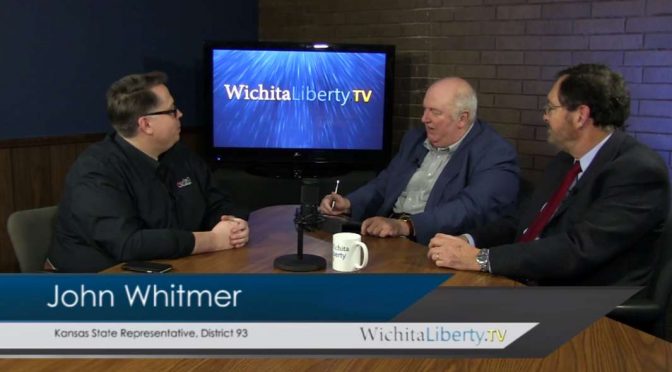Candidates for the Republican Party nomination for United States Congress from the fourth district of Kansas have filed campaign finance reports for the first two weeks of July and some last-minute reports since then.
The reports show Wichita businessman Wink Hartman continuing to self-finance his campaign, with $0 in outside contributions collected in July. His campaign continues to spend at a rapid pace.
The candidates for this nomination and their campaign websites are Wichita businessman Jim Anderson, Wichita businessman Wink Hartman, Wichita businessman Mike Pompeo, Latham engineer Paij Rutschman, and Kansas Senator Jean Schodorf.
Here is a summary of FEC campaign finance reports for the first part of July 2010:
Kansas Fourth District Republican campaign finance reports,
July 1, 2010 through July 14, 2010
Anderson Hartman Pompeo Schodorf
Contributions 2,060 0 49,347 14,891
Candidate loans 0 289,537 0 0
Expenditures 2,240 427,872 207,830 23,172
Cash balance 4,049 40,958 286,032 8,823
Figures for Rutschman were not available at the FEC data site.
Figures that stand out in this report include zero dollars raised by the Hartman campaign from individual contributions. All money raised during this period came from the candidate himself.
Also, Hartman spent more than twice as much as the second-largest spender.
Pompeo has, by far, the largest cash balance as of July 14. Normally this would be a positive factor as the campaign proceeds to election day. Hartman’s smaller cash balance, however, has little of the normal meaning associated with it, as the candidate makes frequent contributions to his campaign as funds are required. This is characteristic of self-financed campaigns.
From the start of the election cycle through July 14, 2010, the numbers look like this:
Kansas Fourth District Republican campaign finance reports,
through July 14, 2010
Anderson Hartman Pompeo Rutschman Schodorf
Contributions 38,924 141,949 935,087 80 50,338
Candidate loans 3,275 1,563,137 0 30,000 29,006
Expenditures 37,301 1,664,129 649,054 24,464 70,521
(Rutschman’s figures are through June 30, 2010)
In this table we see the largely self-financed Hartman campaign outspending all other candidates. His campaign has spent more than twice as much as all other campaigns together.
This still isn’t the entire story, as candidates are filing “48 hour notice” reports of last-minute contributions (expenditures are not included in these filings). Through July 28, 2010, here are the numbers:
Anderson Hartman Pompeo
Total 5,100 348,500 35,700
(Schodorf and Rutschman have not filed any of these reports.)
In the case of Hartman, the total of $348,500 is all from the candidate himself. Overall, the Hartman campaign has raised $2,053,586, with 93 percent from candidate self-financing.
According to OpenSecrets.org, a project of the Center for Responsive Politics, the average amount spent by winning candidates in 2008 for the U.S. House of Representatives was $1,372,591. Hartman is well over this figure.
Each House district has roughly the same population, although the cost of running campaigns varies widely due to the differing characteristics of districts.
Self-financed candidates
As the Kansas fourth district has one candidate who is self-financed, let’s take a look at self-financed candidates and their characteristics.
In writing about political scientist Jennifer A. Steen and her book, Self-Financed Candidates in Congressional Elections (University of Michigan Press, 2006), Bruce Bartlett wrote this:
One of her findings is that the necessity of asking people for contributions is valuable to a candidate, especially inexperienced ones. She thinks this is mainly because self-financing keeps bad candidates from being weeded out of contention by a lack of contributions. But I think it also results because once people have given someone a campaign contribution they become invested in that candidate and are more willing to vote for him or her on Election Day and to work on his or her behalf.
Voters also resent candidates who appear to be trying to buy an election. Self-financed candidates may be independent of special interests, but they also often appear aloof from the concerns of average voters. Having to ask people for money forces a candidate to take their feedback, thus learning about their concerns directly rather than filtered through pollsters and consultants.
In her book, Steen writes: “They [self-financers] are also less likely to engage in what Richard Feuno calls ‘two-way’ campaigning, or interaction between the candidate and constituency, which thus entails some degree of learning and responsiveness on the candidates part.”
Perhaps as a result, self-financed candidates don’t have a very good track record of winning elections. Steen found that for competitive U.S. House of Representative districts, candidates who are “extreme self-financers” (Hartman falls in this category) won 37 percent of primary election contests. That winning percentage falls to 31 percent in general elections.
Voters are interested in what type of representative a candidate would make. Do self-financed candidates differ from other candidates once in office? Steen writes: “These differences do not recommend self-financers as representatives. They are quite unlike the vast majority of citizens, even citizens in more affluent districts, and they are less likely than non-self-financers to confront and engage the citizens they seek to represent.”
Self-financed candidates usually claim that since they have a source of campaign funds independent from the usual sources — which these candidates usually describe as “corrupt” or undesirable in some other sinister way — they can act in the best interests of all their constituents once in office. But Steen found differently: “However, once elected most self-financers assimilate very rapidly to the norms of fund-raising — only a small percentage continue to resist the charms of campaign contributors.”
 Kansas fourth Congressional district campaign finance
Kansas fourth Congressional district campaign finance
 Kansas fourth Congressional district poll results
Kansas fourth Congressional district poll results Kansas fourth Congressional district poll results averaged
Kansas fourth Congressional district poll results averaged Kansas fourth Congressional district poll results
Kansas fourth Congressional district poll results Kansas fourth Congressional district campaign finance
Kansas fourth Congressional district campaign finance Kansas fourth Congressional district poll results
Kansas fourth Congressional district poll results